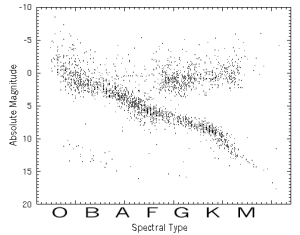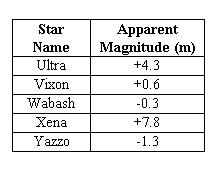- The longest living stars are those of
- high mass.
- low mass.
- intermediate mass.
- The distances to a star can be found by
- Doppler shifting.
- temperatures.
- parallax.
- sonar echoing techniques.
- We do not see stars in the daytime because
- of the lack of contrast with moonlight.
- they simply don't exist in the daytime part of the sky.
- skylight overwhelms starlight.
- the Sun blocks their view.
- The H-R Diagram, an important tool of astronomers, relates stellar temperature to stellar
- color.
- distance.
- brightness.
- mass.
- The temperature of a star is evidenced by its
- brightness.
- rate of burning.
- distance.
- color.
- The brightness of a star as seen from the Earth is its
- total output.
- apparent magnitude.
- absolute magnitude.
- apparent output.
- A magnitude 11 star is _____ than a magnitude 3 star.
- brighter
- hotter
- dimmer
- cooler
- A red star is _____ than a blue star.
- brighter
- hotter
- dimmer
- cooler
- A small-mass star will last _____ a large-mass star.
- longer than
- for a shorter time than
- just as long as
- A red-shift in the spectrum of a star indicates that the star is
- dying.
- moving toward the Earth.
- moving away from the Earth.
- growing in size.

Where on this HR Diagram would you plot a star similar to our own sun?- Lower left.
- Lower right.
- Upper left.
- Upper right.
- Near the center.

Where on this HR Diagram would you plot a relatively small, hot star?- Lower left.
- Lower right.
- Upper left.
- Upper right.
- Near the center.

Where on this HR Diagram would you plot a relatively large, hot star?- Lower left.
- Lower right.
- Upper left.
- Upper right.
- Near the center.

Where on this HR Diagram would you plot a relatively large, cool star?- Lower left.
- Lower right.
- Upper left.
- Upper right.
- Near the center.

Where on this HR Diagram would you plot a relatively small, cool star?- Lower left.
- Lower right.
- Upper left.
- Upper right.
- Near the center.

Where on this HR Diagram would you plot a Red Giant star?- Lower left.
- Lower right.
- Upper left.
- Upper right.
- Near the center.

Where on this HR Diagram would you plot a Blue Giant star?- Lower left.
- Lower right.
- Upper left.
- Upper right.
- Near the center.

Where on this HR Diagram would you plot a White Dwarf star?- Lower left.
- Lower right.
- Upper left.
- Upper right.
- Near the center.

Where on this HR Diagram would you plot a Red Dwarf star?- Lower left.
- Lower right.
- Upper left.
- Upper right.
- Near the center.
- What causes the dark bands observed in a solar spectrum?
- the emission of specific elements
- different chemical elements which absorb light at specific wavelengths
- highly compressed, glowing gas
- warmer gas in front of a source that emits a continuous spectrum
- The apparent shift in a star's position caused by the motion of the observer is called
- luminosity.
- absolute magnitude.
- apparent magnitude.
- parallax.
- Star A has an apparent magnitude of -1.5. Star B has an apparent magnitude of +3.5.
What is the difference in magnitude between the two stars?- 5 magnitudes
- 4 magnitudes
- 3.5 magnitudes
- Impossible to tell
- Star X has an apparent magnitude of 4.0. Star Y has an apparent magnitude of 1.0.
How much brighter is the brighter of these two stars compared to the dimmer of these two stars.
(Brightness Ratio = 2.5^Delta(m) ; Delta(m) is the difference in magnitude between the stars)- X is about 3 times brighter than Y
- Y is about 3 times brighter than X
- X is about 16 times brighter than Y
- Y is about 16 times brighter than X
- Star E shows a parallax angle (p) of 0.004 seconds of arc. How far away is star E from the Earth? Include units.
(Distance in parsecs = 1 / p ; Distance in light-years = 3.26 / p)- 250 parsecs
- 4000 parsecs
- 815 parsecs
- 0.004 parsecs
- A man is reading a magazine one foot from a 100 watt light bulb.
How many 100 watt light bulbs would be needed to receive the same amount of light from 3 feet away?
Brightness = 1 / (Distance)^2- 1 bulb
- 3 bulbs
- 9 bulbs
- 100 bulbs

Which star appears the brightest?- Ultra
- Vixon
- Wabash
- Xena
- Yazoo

Which star would appear dimmest to the unaided eye?
(Hint: on a very dark night most people can just make out a 6th magnitude star.)- Ultra
- Vixon
- Wabash
- Xena
- Yazoo

Which star (or stars) would require binoculars or a telescope to see?- Ultra
- Vixon
- Wabash
- Xena
- Yazoo

The diagrams represent the spectrums of a star and of a stationary gas here on Earth.
How is the star moving with respect to the Earth?- The star is moving toward the Earth.
- The star is moving away from the Earth.
- The star is moving both ways.
- The star is not moving.